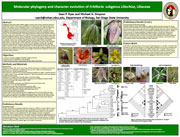NEWS 2011
Molecular Phylogenetic Relationships and Character Evolution of Fritillaria subgenus Liliorhiza
RYAN, Sean* & SIMPSON, Michael G
Botany 2011
St. Louis, Missouri, USA
PSY048 – Poster
*San Diego State University, Biology, Evolutionary Biology Program, 5500 Campanile Drive, San Diego, CA, 92182, USA
Abstract
Fritillaria subgenus Liliorhiza (Liliaceae) is an attractive group of mostly North American geophytes whose evolutionary history has not been fully explored. Abundant synonymy and inconsistent species delimitation need to be addressed in order to make appropriate conservation decisions regarding rare taxa in the group. The most extensive molecular phylogenetic study (Ronsted et al. 2005) included only 12 of the approximately 20-25 species in the subgenus. Recent morphology-based classifications (Santana, 1984; Rix, 2001) are in conflict and may be resolved by further morphological and molecular study. My study aims to determine phylogenetic relationships of all described taxa in the group, to evaluate taxonomic classifications (including questionable species and varieties), and to explore morphological character evolution. To accomplish these goals, I will collect several specimens per taxon, sequence two chloroplast regions (rpl16 and matK) and nuclear ribosomal ITS and ETS, and study morphological characters offlowers, pollen, fruits, seeds, leaves, and bulbs. Preliminary results of molecular phylogenetic analyses and ancestral character state reconstructions will be presented. Previously hypothesized subdivisions based on morphology are partially supported in the molecular analysis, but a complete molecular dataset must be obtained before any definitive reclassification can be made. One moderately supported clade (pp=0.73) corresponds with Subsection Affines of Santana (1984) and Section B1 of Rix (2001) with a few exceptions. Another clade, though not supported, corresponds with Subsection Liliorhiza of Santana (1984) and Section B2 of Rix (2001). With regard to character evolution, "rice-grain bulblets" appear to be the ancestral state for the group, and have been lost once in a weakly supported clade of four species; whorled leaf arrangement appears to be the ancestral state for the group, and appears to have changed to alternate leaf arrangement a minimum of three times, with one reversal.

